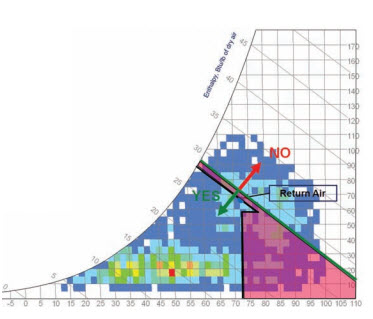
Free cooling uses outside air to cool the building rather than enabling the mechanical cooling. This has the added benefit of improving the indoor air quality, assuming the outside air is not polluted. Free cooling systems are useful in high heat load spaces such as boiler rooms and data centers. Despite the name, free cooling does require energy to move the air but it is an important energy conservation strategy.
There are two common methods for judging if the outside air is worth bringing into the building. The first strategy is simpler and is based on two temperature sensors, one inside the building and one outside. If the air outside is cooler than inside then the system will say free cooling is available. The second type of free cooling is ‘enthalpy based’ and uses both the temperature and the humidity to judge when free cooling is available. Energy stored in moisture is known as latent energy, an enthalpy based system takes this energy into account.
Dry-Bulb-Based Free Cooling System
Dry-bulb sensing is based on a fixed ambient changeover temperature. If the ambient temperature goes above the changeover temperature the system will go directly to the DX compressor-based cooling. On the other hand, if the ambient temperature goes below the changeover temperature, the controls will activate free cooling. The dry bulb based system uses low cost temperature sensors which are easy to maintain so it is popular with HVAC professionals and building owners.
Enthalpy-Based Free Cooling System
Outdoor air is a mixture of water vapor and dry air which takes more energy to cool down than dry air. Additionally moist air will make the occupants uncomfortable and can cause mold. Enthalpy-based sensing uses both a temperature and humidity sensor to make the free cooling decisions. The ambient air is compared to the indoor air and the one with the lower energy wins the free cooling decision. There is also the minimum outdoor intake air setting and the maximum humidity level to take into account, but in between those limits the system will toggle free cooling around a trigger point known as the ‘high limit’ enthalpy control.
An article created by John Hamlin, John Hamlin is a freelance writer who has a background in engineering. With a keen interest in technology and writing, John has been working online providing insight and direction for many years. His latest work has been on a compilation of industrial manufacturing techniques.
